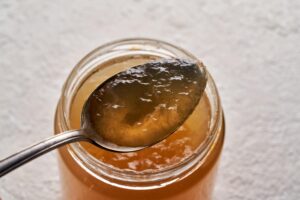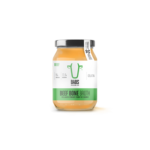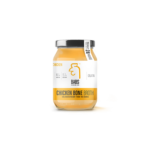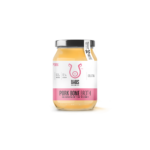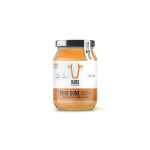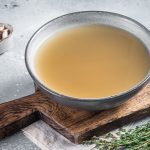If you’re like most people, you’ve never cooked with tallow fat before. Most of us grew up under the mantra: skip the animal fat and bring on those unsaturated plant-based oils!
But, now we’re finding that a lot of the traditional food preparation methods – like slow-simmering bone broth and pickling garden veggies in vinegar – are actually some of the best cooking techniques for ensuring we’re consuming a nutrient-dense diet. Cooking with tallow fat is the latest health food re-discovery that, it turns out, our ancestors had right all along.
Bone Broth for Runners and Triathletes: A Great Training Aid for Hard Workouts
Whether you’re training for your first 5K run or you’re a seasoned triathlete,...
Read MoreWhat is gelatin?
Gelatin is a great source of nutrients that are widely beneficial to your...
Read MoreWhat is bone broth?
The methods for making bone broth today have been modernized for efficiency, sanitation,...
Read MoreThe Problem with Polyunsaturated Vegetable Oils
When studies came out in the early 70s linking a diet high in saturated fat with an increased risk of heart disease, we made saturated fat the black sheep of the food pyramid. But now we’re finding out that a lot of the findings in those studies were never published – and the idea that all saturated fats are bad and all unsaturated fats are good isn’t exactly accurate.
In fact, there are a lot of health benefits of natural, unrefined saturated fat sources such as tallow fat and virgin coconut oil.
Also, switching to polyunsaturated cooking oils introduced a whole new set of problems that we’ve only recently begun to understand.
Most vegetable oils are high in polyunsaturated fats, which are unstable. As a result, they produce a lot of free radicals when heated. Those free radicals can harm your body at the cellular level – causing all sorts of problems such as inflammation and an increased risk of developing degenerative diseases like heart disease, cancer, and Alzheimer’s.
What Is Tallow Fat?
Tallow fat is a really amazing food to integrate into your cooking. Like olive, avocado, and coconut oil, it consists of mostly saturated and monounsaturated fat.
It’s rendered fat, usually from cattle. It can be made from rendering the suet – which is the white fatty layer that surrounds an animal’s organs – or from rendering the fat found within bone marrow.
All of our beef tallow fat is naturally rendered from marrow bones from 100% grass-fed, pasture-raised beef. The resulting tallow is rich in nutrients. It’s loaded with flavor that will enhance all your favorite recipes.
And, it’s really fun to work with in the kitchen – like coconut oil or butter, beef tallow is a solid at room temperature. You can store it in your pantry in an air-tight container for months – or longer – and it won’t degrade. Tallow has a great texture – similar to hard butter – and it will melt when you heat it.
Just a couple of generations ago, beef tallow was what people used to cook with. Not only does it have a very high smoke point and a long shelf life, but it’s also a way to ensure we’re using the whole animal – a practice our forefathers understood the value of and that we’re re-learning how to do today.
Health Benefits of Beef Tallow
Beef tallow isn’t just more flavorful and a better option for high-heat cooking, it offers some surprising health benefits.
Boosts your immune health – with unprocessed fats like beef tallow in your diet, it’s easier for your body to absorb fat-soluble vitamins that support your immune system.
Rich in nutrients – not only does it help you absorb more nutrients from your food, but beef tallow is also rich in vitamins A, D, E, K, and B1.
- Reduces inflammation – tallow contains conjugated linoleic acid, which is a natural anti-inflammatory.
- May help protect the body from infection – one of the fatty acids in beef tallow – palmitoleic acid – possesses fantastic antimicrobial properties, which may help to ward off infections.
- Good for your nervous system – tallow is high in choline, a nutrient that supports the nervous system. Also, the healthy fatty acids help to protect nerve cells.
- Helps the body burn fat – consuming healthy fats stimulates the release of glucagon, the hormone that signals to your body it’s time to burn stored fat to use for energy.
- Softer skin – the saturated fat found in tallow nourishes your skin’s cell membranes, which helps to keep skin smooth. You can also use tallow on your skin as a natural moisturizer!
- Protects your body from free radical damage – not only are you avoiding the free radicals that your body would have to deal with if you cooked with some vegetable oils, but tallow is also rich in vitamin E, which helps to protect your cells from free radical damage.
What Can You Do with Beef Tallow?
You’re going to love cooking with beef tallow. You can fry it, bake with it, and basically use it for any savory dish that requires cooking oil.
Try it for your next omelet. Sauté fresh greens with a little garlic, sea salt, freshly ground pepper, and beef tallow for a new spin on green leafy vegetables. Use it to make an out-of-this-world crust for your pies.
One of my favorite side dishes is to make batata fries with beef tallow. Once you try tallow batata fries, you’ll never be the same person again! They’re that good!


